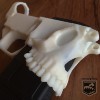Blade First
Member
Given a crucial component that has been essentially unchanged for decades, what do you think can be improved in the basic, stripped AR-15 lower?
I'll go first:
I have a passion for the total elimination of the larger roll pins in a lower assembly. The single most dangerous aspect of a lower build...hammering in the trigger guard roll pin...has a simple solution:
Utilize a 5/32" drill to convert the trigger guard's inside bore to a diameter which will accept threaded brass inserts to be secured by allen-head screws.
Absolutely no assembly stress involved other than being aware that some will want to retain the option of using the detent to lever the trigger guard downward in certain situations.
If that's the case, just torque the screws a bit lighter than solid to retain the pivot function.
What are your ideas on improving the basic lower design?
I'll go first:
I have a passion for the total elimination of the larger roll pins in a lower assembly. The single most dangerous aspect of a lower build...hammering in the trigger guard roll pin...has a simple solution:
Utilize a 5/32" drill to convert the trigger guard's inside bore to a diameter which will accept threaded brass inserts to be secured by allen-head screws.
Absolutely no assembly stress involved other than being aware that some will want to retain the option of using the detent to lever the trigger guard downward in certain situations.
If that's the case, just torque the screws a bit lighter than solid to retain the pivot function.
What are your ideas on improving the basic lower design?





